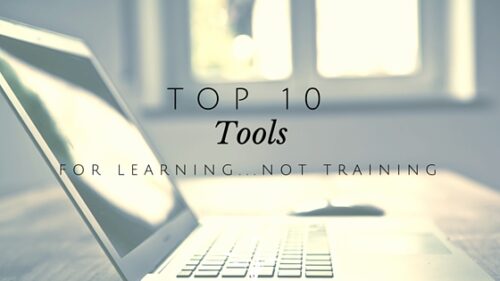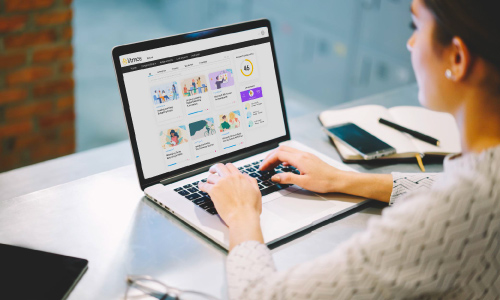Brent Schlenker’s Top 10 Tools for Learning … Not Training
Since 2009 Jane Hart (@c4lpt) has been curating a list of the Top 100 Tools for Learning. She is asking training professionals, and learning professionals, to submit their Top 10 Tools. From that she creates the list of 100. If you’re a learning professional, then submit your list here.
My list has consistently included the tools I use for personal learning and knowledge sharing, not professional tools for authoring or publishing courses.
So, here is my top 10 list for 2015.
1. Evernote
I put everything into Evernote. As their marketing states, it truly is an extension of my brain. I save articles, tweets, posts, as resources for future reference. I also save pictures of where I park my car in airport parking lots. There are so many little life hacks and learning hacks that Evernote supports. It has become my goto app for just about everything.
2. Twitter
If blogging launched my career then twitter definitely extended it. Twitter has become the social glue that holds all the other content together. Nobody publishes anything without sharing it to twitter. And twitter is a great place to ask for help, meet new people, and share your knowledge. There are many power users in our industry, and I don’t claim to be one. But find one and ask them about how they use twitter. It’s a powerful tool for both learning and teaching/sharing.
3. Google Search
There really isn’t much more to say about search. It so ubiquitous in our lives today. Just about anything you want to know is only a search away. But like twitter there are tricks to automating search and using it to be smarter…faster. Learn how to be a power search user and people will think you were born a genius.
4. YouTube
You can learn how to do anything from videos on YouTube. They might as well just call it “The People’s University”. I’ve learned how to fix my car, improve my guitar and drum skills, hack electronics, create craft projects with my kids, and so much more. Video is truly the strongest of all media for learning. And YouTubers will continue to drive the format and master the production techniques that are the most effective. Instructional Design theories are one thing, but nothing beats learning from those who are delivering learning content on a daily basis. The future of “what works” best for learning will be found on YouTube.
5. Kindle App
And for those of you who still enjoy a good book, the Kindle app is amazing. I can learn a lot from reading a book. But I can learn even more by sharing my notes and reading other’s notes about the same book. It’s an interactive experience that you must experience to truly appreciate. I’ve only recently begun using it interactively, but it’s changed my view of reading completely.
6. blab.im
I know the app is only a few weeks old. But it’s already proven to be a powerful learning tool in much the same as twitter…except with video. Anyone can start a blab conversation, and anyone can join a blab conversation. So the serendipitous learning possibilities will be fantastic. The value of seeing someone’s face and hearing their voice is powerful. So while you may get excited about conversing with people on twitter, blab extends that experience to something very personal and much more powerful. But again, you won’t understand unless you experience it for yourself.
7. canva.com
Canva is one of the few creation tools I’ve added to my list. I’ve added it because I use it just about every day to create images. It’s a fabulous learning tool because it has guided my design sensibilities. I will never be a great graphic designer but canva helps me express my message visually in ways I had not thought of. I’m constantly learning and perfecting the images I create. I do believe images are far more powerful than words and so learning to create them is as important as learning how to write.
8. Feedly
I’ve been a big proponent of RSS feeds and feed readers since RSS was first created. I still believe it to be one of the most underutilized technologies in EdTech. Feedly is one of the few remaining RSS aggregators that is a stand alone product. RSS is incorporated into other apps and browsers, but I still prefer the format of the old fashioned RSS feed reader. It’s the fastest and easiest way to consume massive amounts of news, and information.
9. ItunesU
I’ve only recently begun subscribing to ITunesU courses again because a colleague told me about the improvements that have been made. Imagine being able to attend classes at major Universities without actually having to be there… or pay the tuition. With a little bit of motivation there is no reason why anyone can’t get a world class education. ItunesU is just one of many apps making it happen, but it’s my favorite right now.
10. Hootsuite
Managing your social media experience can be a daunting task. Many don’t care about “managing social media”. I do. I learned very quickly in the early years of Web2.0 that engaging with others, via this “new internet”, would pay off. Hootsuite can do a lot. There are many other social media tools for managing your personal brand and personal social learning experience. Hootsuite handles most of what I need accomplished in social media and since much of learning occurs because of social media, Hootsuite is the tool that rounds out my top 10.
There are many many tools that I engage with through out any given week. Compiling this list was NOT easy. There are many others that I use as much as these tools. Narrowing it down to 10 was a matter of reviewing the past few months of productivity and understanding what tools apps were used the most. These are not the BEST…just the ones I currently use the most.






